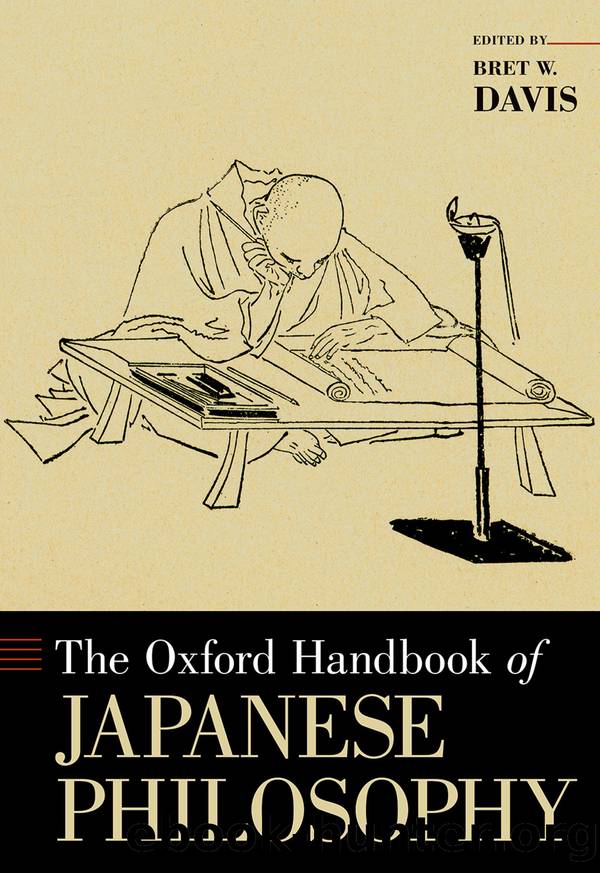The Oxford Handbook of Japanese Philosophy by Bret W. Davis

Author:Bret W. Davis
Language: eng
Format: epub
Publisher: Oxford University Press
Published: 2019-02-15T00:00:00+00:00
A Logic of Fluidity
Things that have been repositioned in three-dimensional space can be measured with âpublicâ yardsticks and spoken of in âpublicâ language. Yet the undivided knowledge-emotion-volition (chi-jÅ-i ç¥æ æ) of the facts of our direct experience themselves can neither be measured nor spoken of in such public manners. In the fourth chapter of the second part of An Inquiry into the Good, entitled âReality,â Nishida expresses this point by saying: âWe must personally realize the true view of reality, rather than reflect on it, analyze it, and express it in words.â14 Nishidaâs critique of positing an opposition of subject and object is thus a critique of the idea that grasping the truth is equivalent to measuring it with public yardsticks and speaking about it in public language.
Let us consider, for example, an exercise such as rotating oneâs arm or swinging oneâs leg forward and backward. By measuring the sequential positions of oneâs arm or leg and the time elapsed between these points, it is no doubt possible to use physics to describe and explain the exercise. But that would not explain the continuity or unity of the exercise, which is precisely how I am conscious of it. Like these exercises, our emotions also have a dynamic quality to them. The emotion of sadness, for instance, is hardly something uniform; its movement is such that at times it tends in the direction of grief, or self-abandonment, or anger. Shifting directions, varying widely, it moves unceasingly. It cannot be summed up in the one word âsadness,â nor can it be precisely grasped by breaking it down into components of grief, anger, and so on since then its unity is lost sight of.
We endlessly attempt to analyze and describe in detail that which changes unceasingly. By dividing up and fixing in place a myriad number of parts and then reconstructing the whole, we attempt to understand that which changes unceasingly. Or else we cut it off at a certain point and try to use that segment to represent the whole. Yet what we actually experience is not an assemblage of divided and fixed pieces; it has rather the quality of a continuous movement that resists being divided up. Such a thing can only be, as Nishida puts it, âpersonally realizedâ (jitoku suru èªå¾ãã). To use Bergsonâs expression, it must be âintuited.â As Bergson says, this requires us to enter deeply into a thing, âto probe more deeply into its life, and by a kind of spiritual auscultation, to feel its soul palpitate.â15
The year before the publication of An Inquiry into the Good, the same year he began teaching at Kyoto University, Nishida published an essay called âBergsonâs Philosophical Method,â in which he expresses sympathy with Bergsonâs notion of âintuition.â He explains it as âseeing a thing from within,â or âseeing by means of becoming a thing itself,â and says that it is the only method with which one can âknow the true state of a thing itself.â16 Sympathy with Bergson also appears in Nishidaâs understanding of âpure experience.
Download
This site does not store any files on its server. We only index and link to content provided by other sites. Please contact the content providers to delete copyright contents if any and email us, we'll remove relevant links or contents immediately.
| Anthropology | Archaeology |
| Philosophy | Politics & Government |
| Social Sciences | Sociology |
| Women's Studies |
Born to Run: by Christopher McDougall(6910)
The Leavers by Lisa Ko(6815)
iGen by Jean M. Twenge(5185)
Sapiens by Yuval Noah Harari(5135)
The Kite Runner by Khaled Hosseini(4971)
Spare by Prince Harry The Duke of Sussex(4812)
Bullshit Jobs by David Graeber(3858)
Machine Learning at Scale with H2O by Gregory Keys | David Whiting(3686)
Never by Ken Follett(3560)
Livewired by David Eagleman(3545)
Goodbye Paradise(3471)
Fairy Tale by Stephen King(2990)
A Dictionary of Sociology by Unknown(2866)
Harry Potter 4 - Harry Potter and The Goblet of Fire by J.K.Rowling(2830)
The Social Psychology of Inequality by Unknown(2780)
The Club by A.L. Brooks(2762)
0041152001443424520 .pdf by Unknown(2637)
People of the Earth: An Introduction to World Prehistory by Dr. Brian Fagan & Nadia Durrani(2627)
Will by Will Smith(2608)
